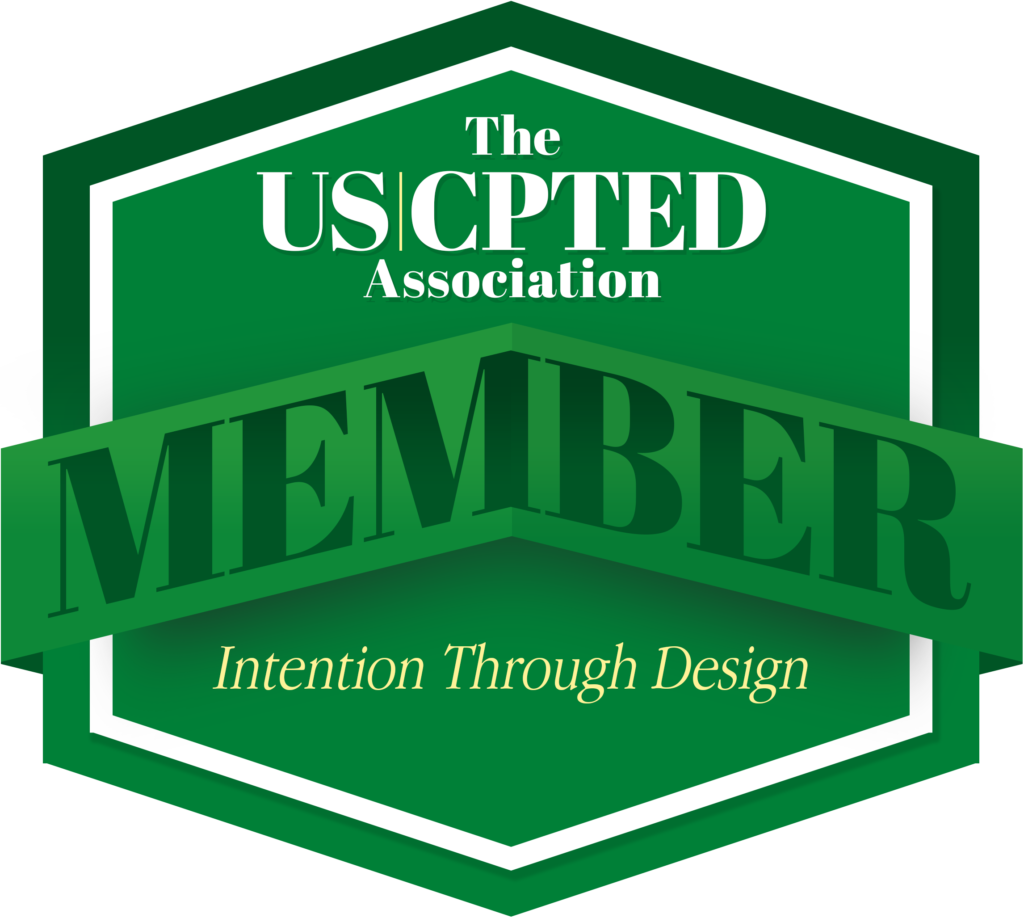
Where – San Diego State University – Fletcher Family Ball Room
Date – February 5-7, 2025
Time – 8:00am – 5:00pm
Topics – TBA
Presenters – TBA
Coming Soon! Member and non-member registration
Registration for the 2025 3 Day US CPTED Association
Third Annual Conference Coming Soon!
Please check back for details!
Would you like to see last years agenda?
or Download
8:00 AM – 8:30 AM Registration / Morning Snacks
8:30 AM – 9:00 AM Welcome – Special Guests – Introduction of US CPTED Association Directors, Introduction of Sponsors / Vendors
9:00 AM – 9:50 AM “Balancing Historic Preservation and CPTED”
Historic theaters are iconic cultural treasures that require a delicate balance between security enhancement and heritage preservation. This case study focuses on a specific historic theater, a historic building, and modern additions in Lynchburg, VA, where CPTED principles were strategically recommended and cautiously applied to address security concerns without compromising the theater’s historical value or violating the preservation requirements to maintain their status as a National Historic Place. The presentation will deliver ways in which CPTED principles were customized to suit the theater’s unique context and the lessons learned from the assessment and implementation process.
Kathleen Jennings, MA, City of Lynchburg, VA Police Department
10:00 AM – 10:50 AM “CPTED and Human Behavior”
This presentation will aim to highlight why CPTED Practitioners should consider universal human behavior in their design recommendation. CPTED typically addresses behavior in the context of how it can be impacted by design. This presentation will take a different approach and show why knowledge of human behavior should be considered to drive a more effective use of designs. Using the 4 pillars of CPTED as a guide, the presenters will demonstrate how a deeper understanding of behavior and the limits of human performance can positively impact purposeful design elements.
Stephan Masson, Human Capital Evolution
11:00 AM – 11:50 AM “Being Proactive as Possible With University Campus Safety Using CPTED “
Safeguards Consulting, a security engineering and technical consulting firm, had a very unique opportunity in 2023 to serve the University of New Mexico in a new role partnering with an architectural firm, Sasaki Associates, to deliver an Integrated Campus Plan for the university where safety was a paramount focus.
The Integrated Campus Plan, which is focused on development and growth of the university for the next 20 years, is traditionally focused on common development and usability benefits, but this project approach was not only of an advanced level because it focused on sustainability and connectivity and then incorporated campus safety as a development focus by the university.
Because of Safeguards Consulting past success with the university and CPTED practices, the firm was added to the team to provide direct CPTED, safety, and security recommendations that would not only highlight focus areas for development, but also guide the overall development recommendations within the plan.
The presenter will cover the distinct value that CPTED provided for the project, the safety drivers for this initiative, the specific applications of CPTED within a master planning project, and discoveries about master planning with a safety focus that were uncovered in this process.
Mark Schreiber, CPP, Principal Consultant
Safeguards Consulting
12:00 PM – 1:00 PM Lunch on your own
1:00 PM – 1:50 PM “Neighborhood Crime Issues and the Application of CPTED in Gas Stations in Detroit, MI”
This abstract introduces ongoing research involving a collaboration with the Detroit Police Department, focusing on violence reduction within Detroit’s Tenth Precinct. The study involves a three-year grant from the U.S. Department of Justice, emphasizing citizen involvement in crime prevention. Our initial year’s efforts concentrated on engaging residents in crafting an action plan to combat crime, employing historical crime data (2013-2023) to identify hotspots, including five problematic gas stations. Community engagement activities included impactful events and a comprehensive survey to gather resident input, revealing consensus on priority areas for improvement, such as addressing problematic gas stations, loitering, and speeding through code enforcement and CPTED strategies. Residents also emphasized the need for community policing improvements, police presence, and innovative solutions for blighted properties. The presentation will focus on presenting a summary of CPTED assessments of six gas stations in the target area and their relationship to crime as well as perception of crime. The community’s perception, which complements historical hotspot analysis, sheds light on the role of environmental design in shaping crime and quality of life. The outcomes of this presentation will be helpful for policymakers, planners, and law enforcement agencies, offering strategies for targeted policing, environmental design enhancements, and resource allocation.
Authors
Linda Nubani, PhD. Associate Professor in Interior Design. School of Planning, Design, and Construction. Michigan State University. nubanili@msu.edu
Julie M. Krupa, Ph.D., Assistant Professor, School of Criminal Justice, Michigan State University. krupajul@msu.edu
Alaina De Biasi, Ph.D., Assistant Professor, Department of Criminology and Criminal Justice, Wayne State University. adebiasi@wayne.edu
2:00 PM – 2:50 PM “CPTED and Premise Liability – Florida HB 837”
Comprehensive analysis of House Bill 837, exploring its nuances and the implications it holds for the multi-family housing industry.
A thorough examination of the stipulated requirements within the house bill allows for a presumption against liability. Crime Prevention Through Environmental Design (CPTED) and its practical application in the context of assessments for Multi-Family housing properties.
A strategic framework proposed to achieve “substantial” compliance with HB 837.
Mario De Graff, Signal 14
Mike Dally, Signal 14
3:00 PM – 4:15 PM Panelists Presentation “CPTED – The critical first line of defense & preparedness when countering the threat of active shooter & violent critical incidents.”
This panelist presentation will endeavor to convey the knowledge, experience and expertise of a global panel comprising of four renowned professionals with practical and theoretical law enforcement, physical security, CPTED, and ACTIVE Shooter specialist skills.
This panelist presentation will deep dive into the risks and threats posed by potential ACTIVE Shooters, the rationale and thought process behind the decisions of their premediated and calculated life changing acts of senseless violence aimed at innocent victims and their families.
Our panel will open the conversation further whilst highlighting the preparedness and countermeasures strategies that CPTED can significantly heighten and improve when implemented correctly and consistently at all levels from business to schools and beyond.
This panel discussion will flow seamlessly from beginning to end with four passionate and experienced presenters guided by Terry Conlon and a slick visually captivating background PowerPoint invoking the presenters and audiences’ thoughts, opinions, and real-time recommendations.
The risk and threat posed by Active Shooter and Violent Critical incidents is very much real, therefore, it is critical that we plan, prepare, and have countermeasures in place that can and will make our citizens safer – crime prevention through environmental design is a vital tool that will be explored in great depth throughout the presentation, educating and empowering delegates.
Terry Conlon, PC, PGC, ACI, CPD, RFC Security Group
Joseph Hendry, PSP, CLEE, Navigate 360
Rodney Andreason, Xscpt, LLT
Carlos Austin, FCP, Miami Gardens, FL Police Department
4:15 PM- 4:30 PM Summit Announcements
8:30 AM – 9:00 AM Announcements – Morning snacks
9:00 AM – 9:50 AM “Blinded by the Light? Street Lighting’s Impact on Crime Prevention”
Understand the influence of LED street lighting conversions on specific index crimes, assessing the deterrent effect and territorial reinforcement.
Examine changes in community perceptions of safety and empowerment, exploring the impact of LED street lighting on community engagement in crime prevention.
Evaluate the effectiveness of advanced LED technologies in enhancing visibility and security, considering both benefits and challenges in crime prevention.
Discuss potential policy implications for urban planning and crime prevention based on the findings, with recommendations for future street lighting initiatives with a community engagement focus.
Ari Isaak, GISP, CFLC, Founder – Evari GIS Consulting
10:00 AM – 10:50 AM “Applying CPTED in Your Campus Master Plan and Construction Standards”
Updating current campus construction Standards to reflect CPTED. Working with campus stakeholders to make them aware of the CPTED advantages. Updating way finding from Static to Interactive displays.
Enforcing CPTED Certified reviews for all new constructions and renovation designs.
Christina Costa, Project Manager and Certified Facilities Professional, University of Texas at Austin
Richard Costa, Project Manager, Certified Facilities Professional, University of Texas at Austin
11:00 AM – 11:50 AM “Enhancing Economic Development through Crime Reduction: The Role of CPTED Design Ideas in Urban Renewal”
Urban areas worldwide grapple with the complex challenge of fostering economic development
while ensuring the safety and well-being of their residents. Crime Prevention Through
Environmental Design (CPTED) offers a compelling approach to address this challenge,
asserting that the physical environment profoundly influences criminal behavior. By integrating
CPTED design ideas into urban development strategies, cities can experience a myriad of
benefits, particularly in economic growth.
One of the primary benefits lies in the creation of a safer and more attractive environment,
fostering a sense of security among residents, businesses, and visitors. CPTED principles
emphasize natural surveillance, territorial reinforcement, and natural access control.
Strategically placed surveillance cameras, well-lit public spaces, and clearly defined property
boundaries contribute to an environment where criminal activities are deterred, promoting a sense of safety and confidence.
Jack Callanan, brivo
12:00 PM – 1:00 PM Lunch on your own
1:00 PM – 1:50 PM “Reducing Radicalization Through CPTED Principles by Protecting and Reinforcing Sense of Community and Activity Support in Community Spaces”
There’s no doubt that Americans are more vulnerable to propaganda delivered through social media and research demonstrates Americans seem to be lonelier and more isolated than previously thought. When this occurs, the potential for radicalization increases.
Infrastructure is needed to increase the opportunity for socialization, including more social spaces, like parks, pedestrian areas such as open streets, and mass attractions, which can increase the quality of life and at the same time reduce dependency on social media. These spaces are often under protected or not protected at all. We will look at how Placemaking and CPTED principles of sense of community and activity support work together to reduce the potential for radicalization by fostering social connections and how we can learn to effectively protect these areas from threats such as vehicle ramming or unintentional vehicle incursions.
Herber Ubbens, CPP, PSP Paratus Consultants Group, LLC
2:00 PM – 2:50 PM “Using CPTED in Homeless Recovery”
SacNav,Inc. a distinguished California nonprofit organization, has meticulously devised and implemented a comprehensive program that leverages Crime Prevention Through Environmental Design (CPTED) as a pivotal instructional component. The primary aim of this initiative is to empower individuals in recovery, encompassing those facing homelessness and addiction challenges, by equipping them with the requisite skills and knowledge to effectively utilize available resources and effect meaningful change within their communities.
Chris Evans, CPD Executive Director Antelope Property Business Improvement District (PBID)
Rebekah Evans, CPD SacNav, Inc. & Evans Consulting
3:00 PM – 4:15 PM “Future of CPTED – Where are we today?”
Panel discussion on the future of CPTED in the realm of public policy and community engagement. From public health, community planning, community self-policing, and shrinking budgets, the panel will discuss various approaches to include CPTED as part of your program.
Jamie Rae Walker, PhD Texas A & M University
Panel TBA
4:15 PM – 4:30 PM Summit Announcements
8:30 AM – 9:00 AM Announcements – Morning Snacks
9:00 AM – 9:50 AM “Security Technology: Friend or Foe?”
Technology is often viewed as a “quick fix” to security problems, especially when the issue revolves around the existing built environment. Rather than utilizing good CPTED practices, cameras take the place of Natural Surveillance, remote intercoms take the place of Natural Access Control, and so on. While existing buildings can be difficult to change, this technology focused mindset is frequently applied to new construction as well, creating a disconnect in the human experience.
Explore strategies to integrate Security Technology along with CPTED Principles to allow for these devices to work in harmony with the built environment, creating a more holistic security solution. Understanding the realistic abilities and limitations of security devices, along with a user’s ability to maintain these systems, is key to successfully deploying them. Budgetary implications must also be considered, and recognizing when implementing a phased approach utilizing policies and procedures in the short-term could be the best overall strategy.
Ben Crum, President, Architectural Security Design Group
10:00 AM – 10:50 AM “Graffiti Abatement Through Art Installation”
“With a surge in the number of incidents of graffiti, and the astronomical costs associated with the removal and clean-up, something must be done. See what the City of Auburn has done to combat this problem. With the implementation of Crime Prevention Through Environmental Design (CPTED) philosophies, the City of Auburn has decreased the number of incidents with the installation of public art. This session will show a 30,000 foot overview of what they have done, what is working, and how to get started.”
Chris Barack, City of Auburn, WA
11:00 AM – 11:50 AM “Small Scale CPTED – Applying CPTED Principles to Individual / Commercial Properties”
While we often apply CPTED to neighborhoods and large properties such as schools, hospitals, or transit centers, the adaptation of CPTED principles for smaller, individual-lot properties can have a positive impact in decreasing and deterring crime, even from businesses that are often targets for crime. In this presentation, we will explore the application of primary CPTED principles (Natural Surveillance, Natural Access Control, Territorial Reinforcement, and Maintenance) and the elevation of a fifth principle – Social Management – in several single-lot, commercial bank properties to show a positive effect on crime statistics and an increased deterrence in crime resulting from the perception of increased security.
D. Joshua Troxell, Vice-President, and Senior Regional Security Consultant for First Citizens Bank.
12:00 PM – 1:00 PM Lunch on your own
1:00 PM – 1:50 AM “Enhancing Public Space Safety of the W. D. Hill Recreation Center through a CPTED-Focused Planning Process”
This presentation will delve into the history and current conditions of the W. D. Hill Recreation Center in Durham, NC. It aims to highlight the development of strategic recommendations in line with the principles of Crime Prevention Through Environmental Design (CPTED), a key factor in public space planning and design. The focus will be on how incorporating CPTED principles can enhance safety perceptions, improve physical security, reduce negative behaviors, and promote community well-being. This session will offer an overview of preliminary recommendations and the progress achieved thus far. Additionally, it will shed light on the practical challenges faced by local governments in establishing and financing such projects, securing public support, and aligning the project’s objectives with the expectations of the public and local officials.
Lindsay Smart, AICP, CPD Sr. Park and Trails Planner, City of Durham
2:00 PM – 2:50 PM “CPTED Mix and Match”
This will include a series of short topics that relate to a variety of CPTED applications. A few of those include lighting strategies & standards, window glazing, security systems, CCTV, etc.
Ben Crum – Window Glazing
Mark Schreiber – Security Systems / CCTV
Rusell Kolins – Premise Liability and CPTED
Art Hushen – Lighting
Additional Panel Members TBA
3:00 PM “Closing Comments – US CPTED Conference 2025”
Hours and topics are subject to change.
Marshall Student Center Ballroom– Conference Location
Crescent Hill Parking Garage for parking – Follow signs to parking deck.
University of South Florida Campus Map
https://www.usf.edu/student-affairs/parents/documents/pfe_ffw_campusmap_tampa.pdf

Sign Up for Membership today!
- Professional Recognition
- Access to education and training
- Networking opportunities
- Access to the membership directory
- Improve your professional profile
- Memberships discounts
- Access to the US CPTED Association Library
- Certificate of membership
- Opportunities to give back to the CPTED community
- Supporting the US CPTED Association mission

